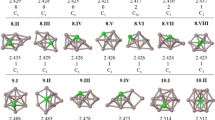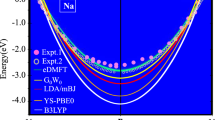Abstract
The electric polarizability of the aluminum atom has become a benchmark for calibration in electric polarizability measurements of clusters during the past decades. However, there is a large discrepancy between the experimentally measured value and the theoretically predicted one. It is worth to clarify the argument through systematic modern calculations. Here, we present high-level computation of the static dipole polarizability of the ground-state aluminum atom by applying the PC-4 basis set with various ab initio methods including Unrestricted-Hartree–Fock, Møller-Plesset perturbation and the coupled cluster. In contrast to the previously calculated values which deviate from the experimentally measured one by 20%, our recommended value of 47.69 a.u. lies within the experimental one of 46 ± 2 a.u. This reconciliates the theoretical with the experimental value again and reaffirms its reliability as calibration for future experiments.


Similar content being viewed by others
References
K. C. Chatzisavvas, S. T. Tserkis, C. P. Panos, and C. C. Moustakidis (2015). Int. J. Theor. Phys. 54, 1481–1491.
W. Z. Wang, M. Z. Rong, A. B. Murphy, Y. Wu, J. W. Spencer, J. D. Yan, and M. T. C. Fang (2011). J. Phys. D: Appl. Phys. 44, 355207.
T. M. Miller and B. Bederson (1988). Adv. At. Mol. Phys. 25, 37.
J. A. Becker (1997). Angew. Chem. Int. Edit. 36, 1390.
T. M. Miller and B. Bederson (1977). Adv. At. Mol. Phys. 13, 1–55.
W. A. de Heer (1993). Rev. Mod. Phys. 65, 611.
W. F. Holmgren, M. C. Revelle, V. P. A. Lonij, and A. D. Cronin (2010). Phys. Rev. A 81, 053607.
L. Ma, J. Indergaard, B. Zhang, I. Larkin, R. Moro, and W. A. de Heer (2015). Phys. Rev. A 91, 010501(R).
A. Derevianko, W. R. Johnson, M. S. Safronova, and J. F. Babb (1999). Phys. Rev. Lett. 82, 3589–3592.
G. Maroulis (2001). Chem. Phys. Lett. 334, 207.
C. R. Ekstrom, J. Schmiedmayer, M. S. Chapman, T. D. Hammond, and D. E. Pritchard (1995). Phys. Rev. A 51, 3883.
P. Milani, I. Moullet, and W. A. de Heer (1990). Phys. Rev. A 42, 5150.
P. Fuentealba (2004). Chem. Phys. Lett. 397, 459.
C. Lupinetti and A. J. Thakkar (2005). J. Chem. Phys. 122, 044301.
E.-A. Reinsch and W. Meyer (1976). Phys. Rev. A 14, 915.
J. Stiehler and J. Hinze (1995). J. Phys. B: At. Mol. Opt. Phys. 28, 4055–4071.
T. Fleig (2005). Phys. Rev. A 72, 052506.
F. Jensen (2007). J. Phys. Chem. A 111, 11198.
D. Feller (1998). J. Comput. Chem. 17, 1571.
R. Krishnan, J. S. Binkley, R. Seeger, and J. A. Pople (1980). J. Chem. Phys. 72, 650.
K. A. Peterson, D. E. Woon, and T. H. Dunning (1994). J. Chem. Phys. 100, 7410.
M. Frisch, G. Trucks, H. Schlegel, G. Scuseria, M. Robb, J. Cheeseman, G. Scalmani, V. Barone, B. Mennucci, G. Petersson, G. et al., Gaussian 09 (Revision E. 01) (Gaussian, Inc., Wallingford, 2013)
J. D. Watts, J. Gauss, and R. J. Bartlett (1993). J. Chem. Phys. 98, 8718–8733.
K. Raghavachari, G. W. Trucks, J. A. Pople, and M. Head-Gordon (1989). Chem. Phys. Lett. 157, 479.
G. D. Purvis and R. J. Bartlett (1982). J. Chem. Phys. 76, 1910.
J. Paldus and J. čížek (1975). Adv. Quantum Chem. 9, 105.
R. J. Bartlett (1981). Annu. Rev. Phys. Chem. 32, 359.
M. Urban, I. Černušák, V. Kellö, and J. Noga, Methods in Computational Chemistry. (Springer, Boston, MA, 1987), pp. 117–250.
G. Maroulis and C. Pouchan (2003). J. Phys. B: At. Mol. Opt. 36, 2011.
E. F. Archibong and A. J. Thakkar (1991). Phys. Rev. A 44, 5478.
D. M. Bishop and G. Maroulis (1985). J. Chem. Phys. 82, 2380.
I. S. Lim and P. Schwerdtfeger (2004). Phys. Rev. A 70, 062501.
J. Speight, Lange’s Handbook of Chemistry, 17th ed. (McGraw-Hill Education, New York, 2016).
J. Mitroy, J. Y. Zhang, M. W. J. Bromley, and K. G. Rollin (2009). Eur. Phys. J. D 53, 15.
L. Hamonou and A. Hibbert (2008). J. Phys. B: At. Mol. Opt. Phys. 41, 245004.
N. Reshetnikov, L. J. Curtis, M. S. Brown, and R. E. Irving (2008). Phys. Scr. 77, 015301.
L. Hamonou and A. Hibbert (2007). J. Phys. B: At. Mol. Opt. Phys. 40, 3555.
A. C. Lasaga and R. T. Cygan (1982). Am. Mineral. 67, 328.
J. Lahiri and A. Mukherji (1967). Phys. Rev. 153, 386.
A. Serr and R. R. Netz (2006). Int. J. Quantum Chem. 106, 2960.
Z. Fu, G. W. Lemire, G. A. Bishea, and M. D. Morse (1990). J. Chem. Phys. 93, 8420–8441.
J. Komasa (2001). Phys. Rev. A 65, 012506.
W. R. Johnson, U. I. Safronova, A. Derevianko, and M. S. Safronova (2008). Phys. Rev. A 77, 022510.
M. Puchalski, D. Kędziera, and K. Pachucki (2011). Phys. Rev. A 84, 052518; Erratum (2012). Phys. Rev. A 85, 019910
R. W. Molof, H. L. Schwartz, T. M. Miller, and B. Bederson (1974). Phys. Rev. A 10, 1131.
D. Tunega, J. Noga, and W. Klopper (1997). Chem. Phys. Lett. 269, 435.
H.-J. Werner and W. Meyer (1976). Phys. Rev. A 13, 13.
K. Anderson and A. J. Sadlej (1992). Phys. Rev. A 46, 2356.
A. K. Das and A. J. Thakkar (1998). J. Phys. B: At. Mol. Opt. Phys. 31, 2215.
C. Thierfelder, B. Assadollahzadeh, P. Schwerdtfeger, S. Schäfer, and R. Schäfer (2008). Phys. Rev. A 78, 052506.
A. J. Thakkar and C. Lupinetti (2005). Chem. Phys. Lett. 402, 270.
S. Chattopadhyay, B. K. Mani, and D. Angom (2014). Phys. Rev. A 89, 022506.
B. K. Sahoo and B. P. Das (2008). Phys. Rev. A 77, 062516.
A. Sadlej and M. Urban (1991). J. Mol. Struct. (Theochem). 234, 147.
G. S. Sarkisov, I. L. Beigman, B. P. Shevelko, and K. W. Struve (2006). Phys. Rev. A 73, 042501.
U. Hohm and A. J. Thakkar (2012). J. Phys. Chem. A 116, 697.
https://www.physics.nist.gov/PhysRefData/Handbook/Tables/aluminumtable5.htm. Accessed 22 Sept 2021.
Acknowledgements
This work was supported by the National Natural Science Foundation of China under Grant No. 11774255, the National Basic Research Program of China No. 2020YFC2004602 and the Key Project of National Science Foundation of Tian** City No. 17JCZDJC30100.
Author information
Authors and Affiliations
Corresponding author
Additional information
Publisher's Note
Springer Nature remains neutral with regard to jurisdictional claims in published maps and institutional affiliations.
Rights and permissions
Springer Nature or its licensor (e.g. a society or other partner) holds exclusive rights to this article under a publishing agreement with the author(s) or other rightsholder(s); author self-archiving of the accepted manuscript version of this article is solely governed by the terms of such publishing agreement and applicable law.
About this article
Cite this article
Wang, K., Fang, SZ., Fan, Z. et al. Reconciliation of the Theoretical and Experimental Value of the Static Electric Polarizability of the Aluminum Atom. J Clust Sci 34, 2147–2151 (2023). https://doi.org/10.1007/s10876-022-02377-5
Received:
Accepted:
Published:
Issue Date:
DOI: https://doi.org/10.1007/s10876-022-02377-5




